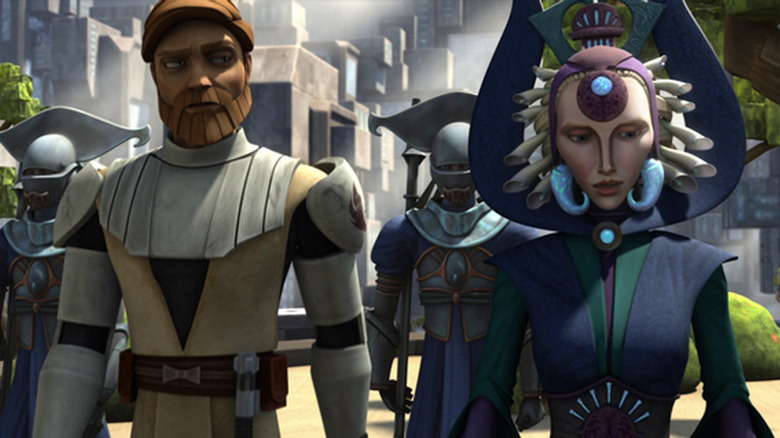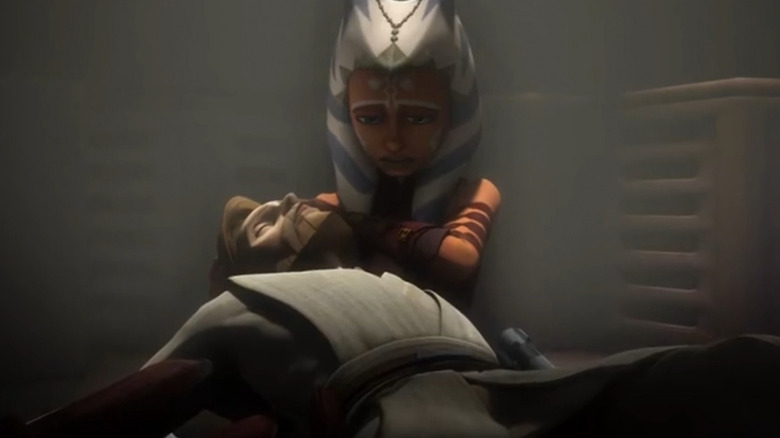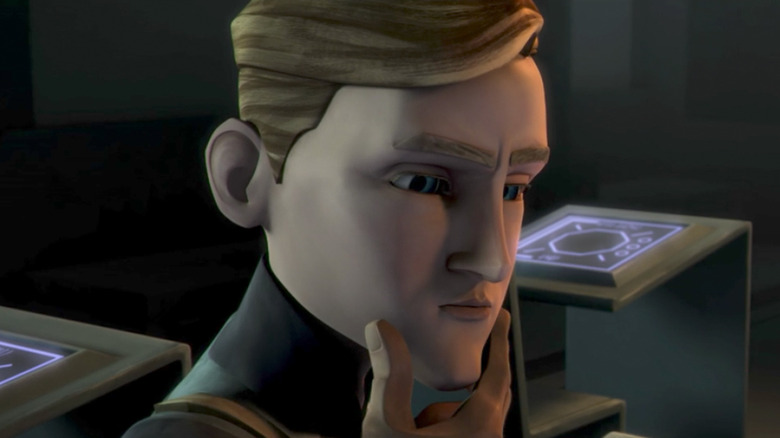Obi-Wan Kenobi Details You Missed If You Didn't Watch Clone Wars
It's been 45 years since "Star Wars" fans first learned what it meant to use the Force. Such knowledge was first bestowed by the enigmatic Obi-Wan Kenobi, a Jedi master with a checkered past and nuggets of wisdom to spare. Since then, he's guided quite a few Jedi throughout the "Star Wars" saga, from the original trilogy to the prequel films. He's had a lot of adventures himself, and it can be hard to keep track of them all — especially now that his story is set to continue in the "Obi-Wan Kenobi" series on Disney+.
The series takes place after "Star Wars: Episode III — Revenge of the Sith," but it will also pull key details from animated shows like "Star Wars: The Clone Wars," which means that fans who skipped the series might have a bit of homework before "Kenobi" premieres on May 27. For anyone curious about the Jedi master's time during the Clone Wars, here's what you need to know.
He's worked with (and fought) Mandalorians
"The Mandalorian" wasn't the first "Star Wars" series to introduce the war-torn planet of Mandalore. Obi-Wan also visits this planet frequently in "The Clone Wars." Not only has he worked closely with Mandalorians, he's also had to fight a few as well.
One of Obi-Wan's strongest allies outside of the Jedi Order is the Duchess Satine Kryze, who rules Mandalore as a peaceful, neutral party during the war. Duchess Satine has frequent run-ins with a splinter government, Death Watch, who strive to bring Mandalore back to their gladiator-like roots.
Obi-Wan is a key player in the conflict between Satine's pacifist ideals and Death Watch's hunger for the old ways. Not only does he save the Duchess from several assassination attempts, but he also trades blows with the Death Watch on more than one occasion.
He almost left the Jedi Order
It might come as a shock to hear that one of the most devout Jedi in history once had doubts about the Jedi Order, but it's true. Obi-Wan once struggled big time with his duties as a Jedi Knight, and it all began when he first met Satine Kryze.
In his early days as a Jedi, Kenobi and his late master, Qui-Gon Jinn, were sent to Mandalore to protect the young Duchess from bounty hunters. The three remained in hiding for a year, and in that time Obi-Wan and Satine developed a forbidden romance. In fact, the two nearly ran away together, since Obi-Wan's duty as a Jedi forbade him for developing strong attachments to anything, and Satine's future on Mandalore was precarious at best.
Eventually, Obi-Wan does choose to remain a Jedi, while Satine becomes the ruler of her people. Though they parted ways, they would reunite on more than one occasion, making for some interesting conflict throughout the Clone Wars.
His rivalry with Maul continues during the war
Obi-Wan might not have been the main protagonist in "Star Wars: Episode I — The Phantom Menace," but his arc throughout the film is pretty important to the Jedi he later becomes. After all, that film introduces Darth Maul, one of Obi-Wan's most ruthless adversaries. Though Obi-Wan triumphs over Maul — by straight-up chopping him in half with a lightsaber — Maul somehow survives.
Officially, Maul's feelings of hatred and his lust for revenge keep him alive. Whether or not that makes complete sense, Maul spends years trying to ruin Obi-Wan's life. He even conquers Mandalore for a time, and imprisons the Duchess Satine in an effort to trap Obi-Wan and make him suffer. Obsessed much?
He knew Tarkin before the age of the Empire
One of the Empire's most formidable leaders was once one of the good guys. That's right: Admiral Wilhuff Tarkin — who famously used the Death Star to blow up innocent planets — was once an officer in the Republic navy. He was high up in the ranks, too, even participating in top-secret missions during the Clone Wars. When one such mission goes horribly wrong, resulting in his capture, Tarkin is actually rescued by Obi-Wan, his padawan Anakin, and his padawan's padawan, Ahsoka Tano.
Notably, Obi-Wan and Tarkin don't exactly see eye to eye. But Tarkin gets close with Anakin during their rescue mission: It turns out both men are friendly with Chancellor Palpatine, and have similar doubts about the Republic. It's an interesting bit of foreshadowing, since Anakin and Tarkin would become two of Palpatine's most trusted enforcers after the Clone Wars.
He once faked his death
Few "Clone Wars" arcs conveyed Obi-Wan's unfailing loyalty to the Republic more than the "Deception" arc in season 4. In this four-part story, Obi-Wan must fake his death and assume the identity of a bounty hunter in order to thwart an assassination attempt. His mission sends him to a high-security prison, and forces him to work with some of the most dangerous criminals in the galaxy.
Things get even more complicated when Anakin tries to avenge the death of his master. It's no secret that Skywalker's got attachment issues, so it's wild that the Jedi Council chose to keep him in the dark on such a personal matter. This arc was one of the first to show Anakin's growing mistrust in the Republic. It also marked the beginning of his fracturing bond with Obi-Wan.
He might have had a son
Obi-Wan's strong faith in the Jedi Code is pretty ironclad, especially when it comes to forgoing attachment, but that hasn't stopped fans from theorizing about his early days as a padawan. Some have speculated that he and Duchess Satine might have done the do while they were together on Mandalore, and that Satine secretly gave birth to a child after Obi-Wan returned to the Jedi. It's possible that Satine's nephew, Korkie Kryze, is actually the child in question. He and Obi-Wan do look a lot alike. Korkie even shares Obi-Wan's thoughtful chin-stroking habit, so the theories aren't exactly unfounded.
Still, it remains a theory. "The Clone Wars" never outright expanded on that idea, nor did they ever address it — but it's hard to ignore the possibility once it's been presented. "Star Wars" creator George Lucas even confirmed that Jedi, while averse to attachment, don't necessarily have to be celibate. The same could be said for Obi-Wan, though some fans believe that theory goes against everything that he stands for as a Jedi.






